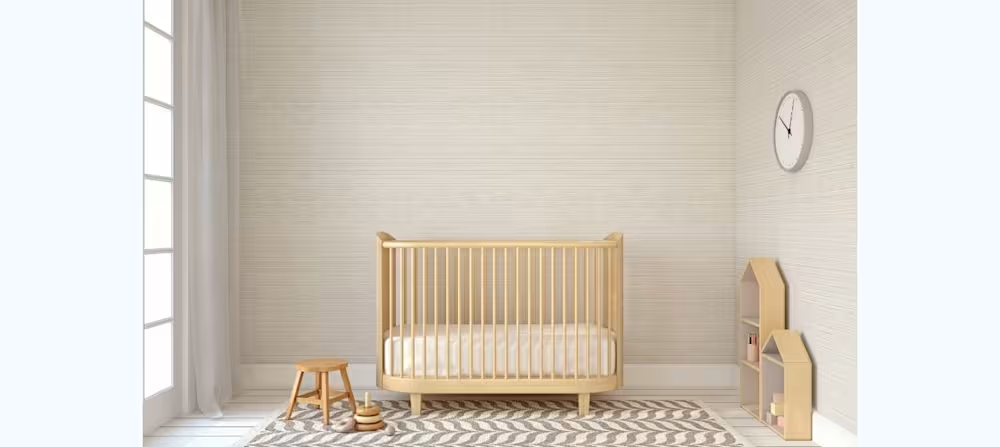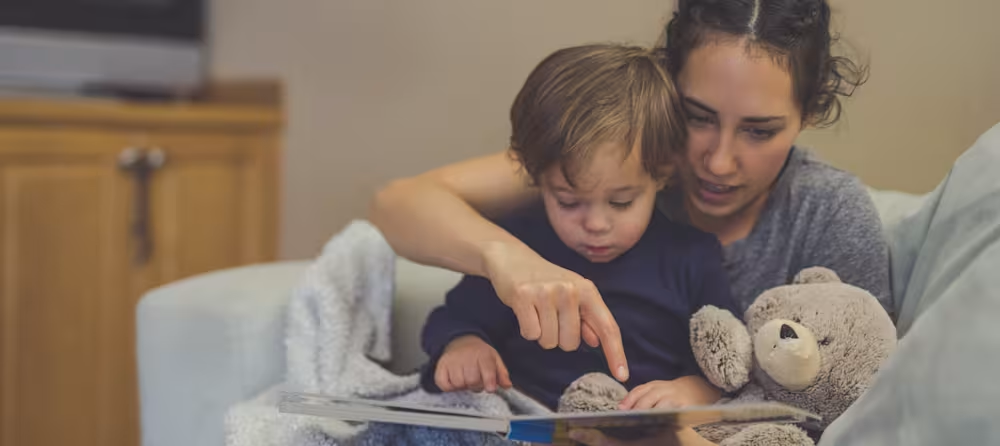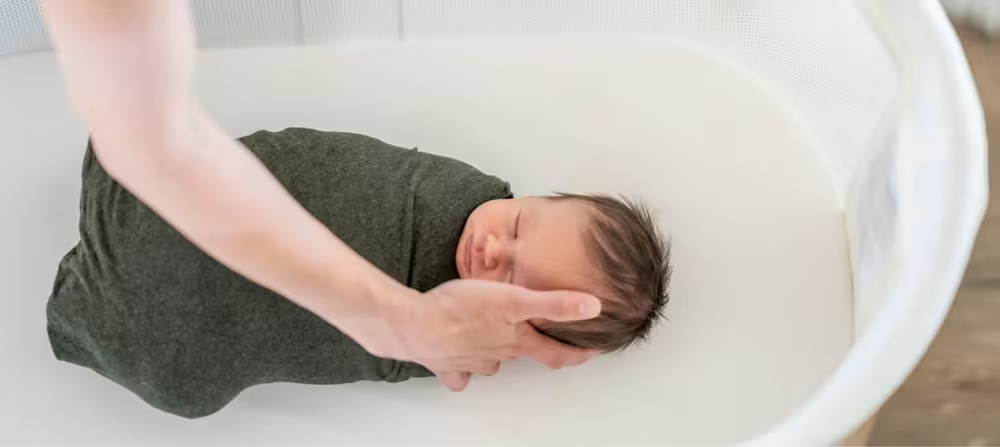How to swaddle a baby for optimal sleep
Updated Oct 16, 2025

At the hospital, the nurses took a simple blanket and created a cozy cocoon for your newborn with just a few folds and tucks. Now that you’re at home, you have no idea how to wrap those wriggling baby limbs in the same way. Sound familiar? If so, get ready to say goodbye to your swaddling insecurities. Welcome to Swaddling 101!
What is swaddling?
Swaddling is a method of snuggly wrapping your baby in a blanket. When done correctly, the blanket should stay secure around the baby, can help calm fussiness, and may even improve sleep.
The technique’s been used for millennia, although modern swaddling undoubtedly looks a bit different than it did during paleolithic times. For one thing, our blankets are probably a lot cuter. We know a lot more about safety now too.
Newborn swaddling can look really easy — especially if you watch a labor and delivery nurse magically wrap your newborn into a baby burrito in under 10 seconds. Don’t be intimidated! In reality, it takes most people some practice to master. (Also don’t hesitate to ask the nursing staff to give you some swaddling tips before you leave!)
Step-by-step how to swaddle a newborn

First, a little disclaimer: Our graphic will make swaddling look simple, but the cartoon baby isn’t kicking like a mini soccer star. Expect that it will take time to master your swaddling technique. If your baby is wiggly or fussy, it can be extra challenging to swaddle correctly. Like with many things in life and parenthood, practice makes progress!
Step 1: Swaddle preparation involves placing your blanket on a flat, firm surface in a diamond shape so that one corner is at the top. Fold this top corner down. How much you’ll want to fold it will depend on the size of your baby and the size of your blanket.

Step 2: Lay your baby onto the blanket (face up) with their head above the folded corner.

Step 3: Gently guide the left arm down to your baby’s side. Take the right corner of the blanket and wrap it around your baby’s left arm and body. Tuck the blanket under their back. Chances are you’ll need to distract your baby. Sing your favorite television theme song, or make funny faces, to grab their attention.
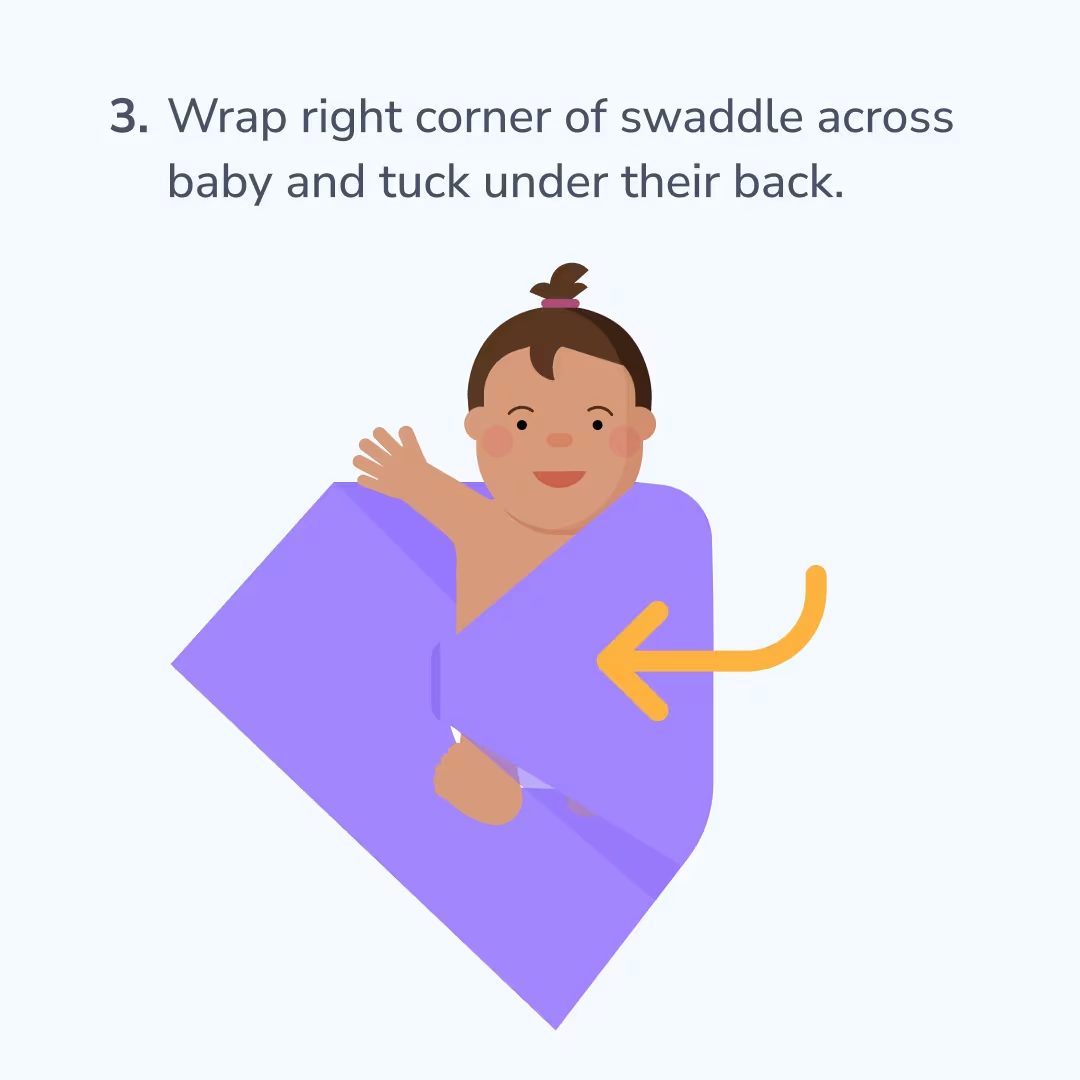
Step 4: Wrap the bottom corner of your blanket over your baby’s feet and tuck it into the top of the first fold. Now guide your baby’s legs so that they’re positioned up and out — like a frog — to ensure they’re enough room. We don’t want the legs to be tightly restricted, as that can cause issues for developing hips.
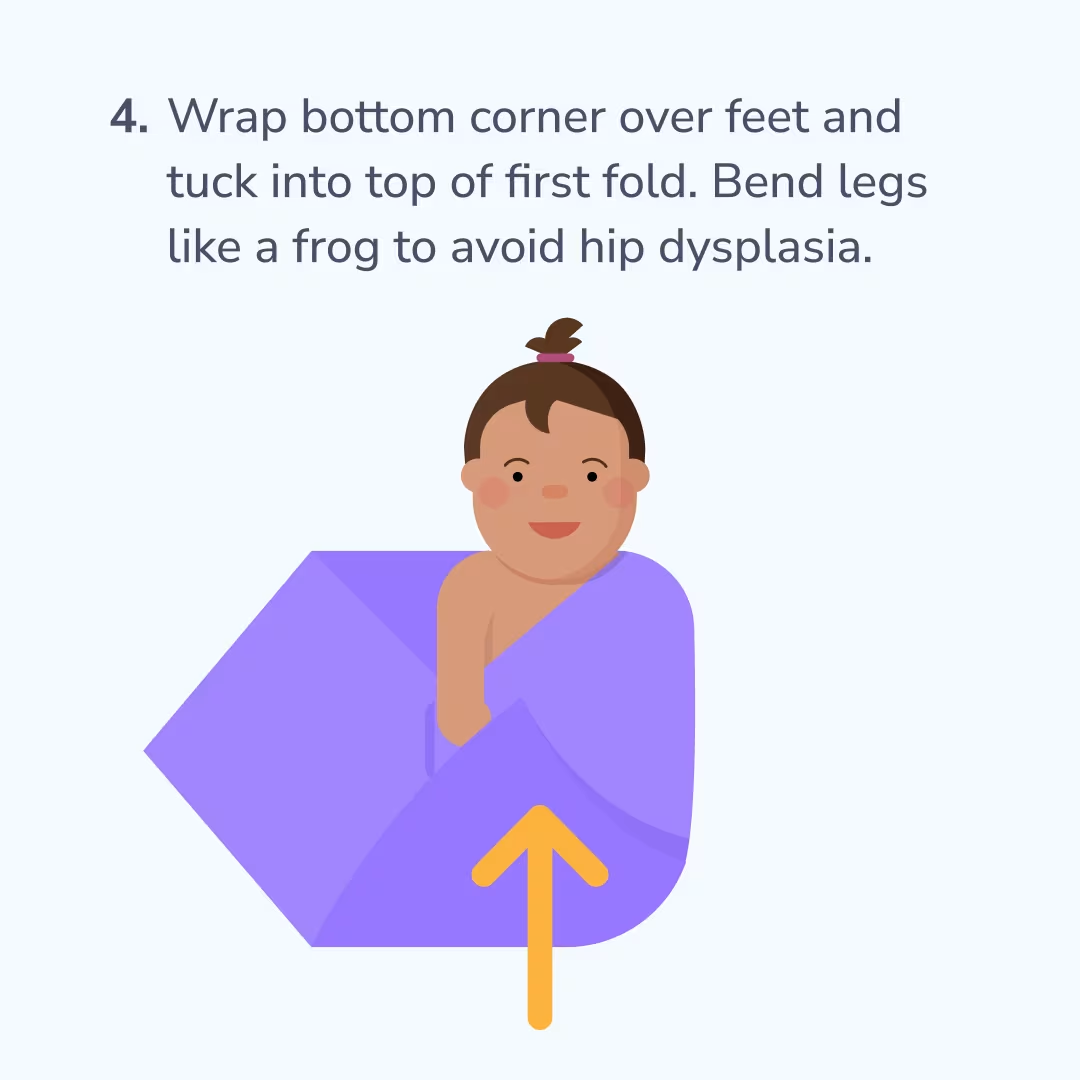
Step 5: Place your baby’s right arm down, against their body, and wrap the last corner (the one on the left side) over and around your baby’s body. Tuck the swaddle into the fold at the back to keep it secure.
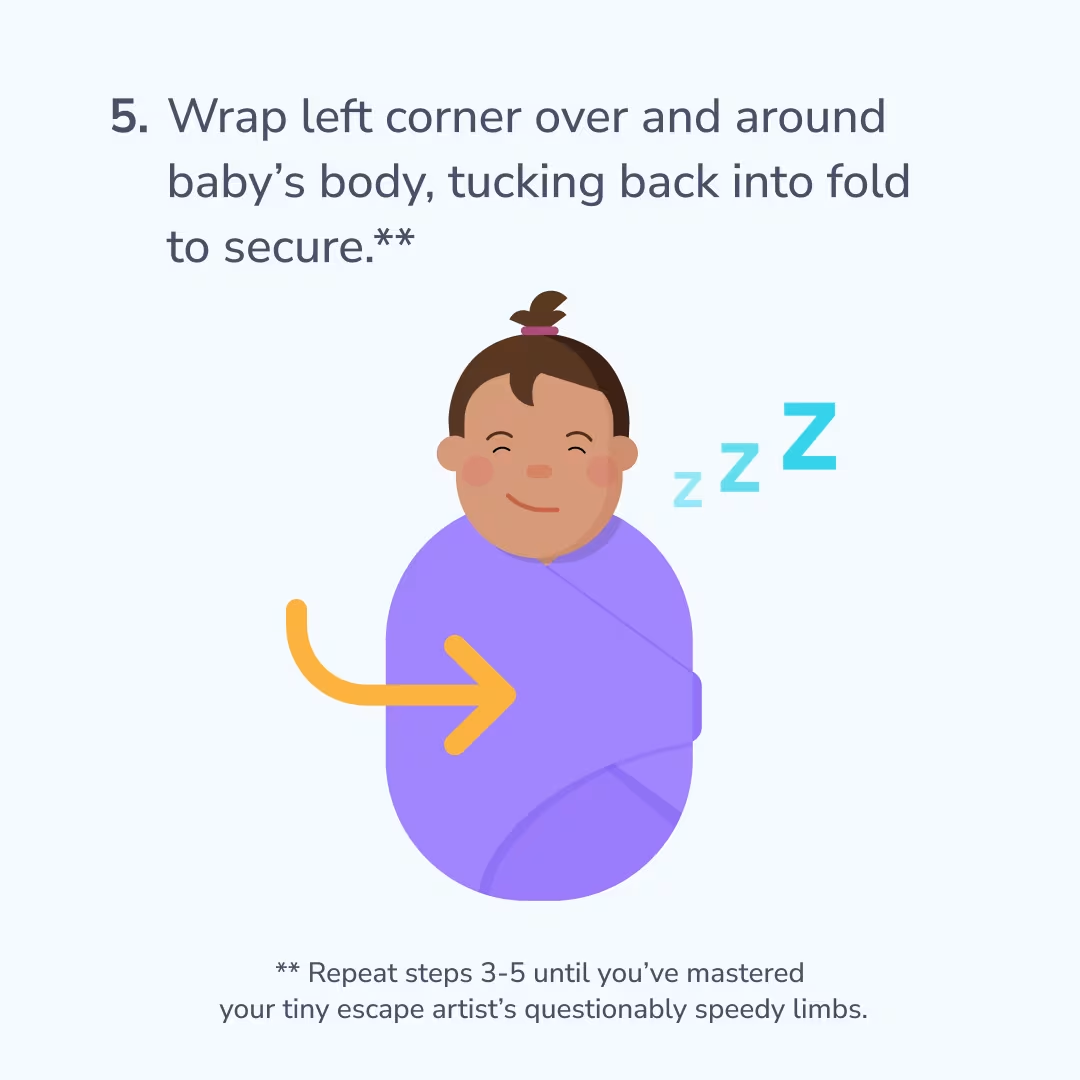
How to swaddle in 5(ish) steps - Overview
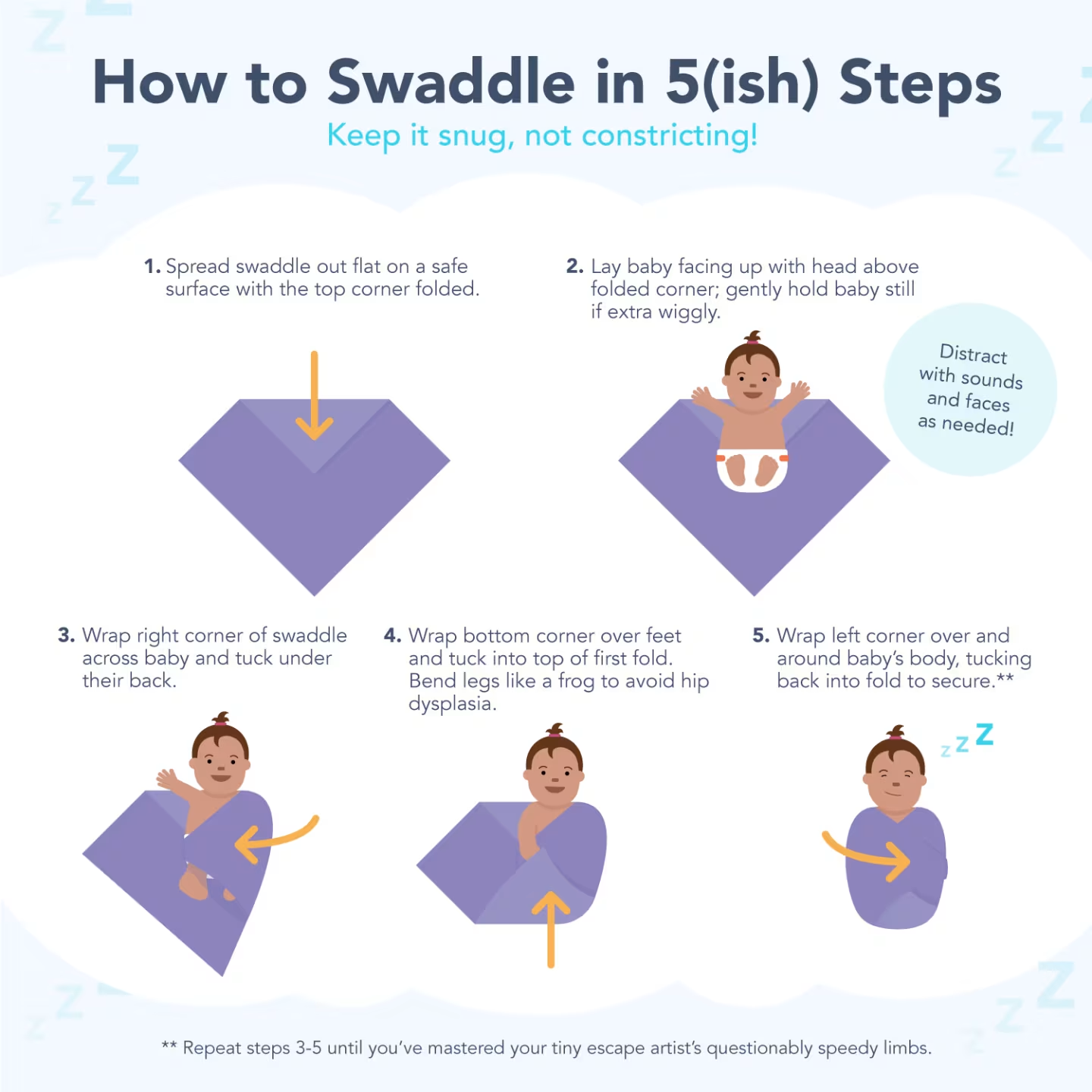
Arms out adaptation
If you want to gradually , you may choose to transition out of the blanket in stages. This works best if your baby is past the newborn stage, but hasn’t shown any signs of rolling yet.
In this case, we’d begin by leaving one or both arms out of the swaddle, so that your baby can get used to having some freedom of movement, while still keeping the rest of the body secure. Once your baby adjusts to having both arms out, you can remove the entire swaddle. Go ahead and swap it out for a wearable blanket, which can provide warmth and comfort, while allowing much more movement of the limbs.

Types of swaddles and how to choose
The great thing about swaddling is that you only need one piece of equipment: a standard rectangular (or square) baby blanket. This will help you get the best swaddle for a newborn!
Do you have to swaddle a newborn? Not exactly. There are other options for swaddling. Today, parents can choose "ready-made" swaddle blankets with zippers and velcro (so you don't need to master folding and tucking). Avoid weighted swaddles; the June 2022 updated AAP guidance for safe sleep [] notes that they are not safe, and therefore not recommended.
For infants that object to having their arms pinned down at their sides, there are also hands-up swaddle blankets. If you’re looking for a swaddle that grows with your child, you might opt for a transitional style that moves from an arms-in swaddle to an arms-out wearable blanket.
There’s no one “right” choice here. The best swaddle and swaddling techniques for your baby can safely be used to improve sleep. Especially big or strong newborns may bust out of a swaddle made from a smaller baby blanket and need a larger blanket or zippered swaddle to ensure that the swaddle doesn’t come undone. These types typically work best if your baby breaks out of the swaddle but can't sleep without it. When using a swaddle blanket, make sure to check the manufacturer’s recommendations for safe use.
Why it works, especially in the so-called "fourth trimester"
A newborn swaddle can improve sleep in two ways. First, it can simulate the womb. This “back in the womb” feeling can help soothe infants and promote sleep. It may also decrease a baby’s arousal, meaning they wake less and sleep longer.
Second, swaddling can help prevent a full awakening caused by the "startle" or Moro reflex []. The swaddle limits the movement of a baby’s arms, which means they’re less likely to awaken when you transfer them to their bassinet, they move around in their sleep, or the dog barks. The Moro reflex typically peaks during the first month and starts to disappear after about 2 months. []
Is it safe to swaddle at night?
Swaddling can help newborns sleep soundly, but it’s not without risk. While “decreased arousal” may improve sleep, it may also be a leading factor in SIDS fatalities.
The American Academy of Pediatrics (AAP) [] recommends monitoring swaddled babies when they sleep. Placing babies on their back and in their own safe sleep space while swaddled is your safest bet. Make sure their sleep space is free of loose bedding and soft items, like pillows or stuffed animals. If you plan on bed-sharing (which the AAP doesn’t recommend), also plan on leaving the swaddle off.
Primary safety concerns include the increased risks of:
SIDS or suffocation if baby rolls over while swaddled, or if blankets become loose
Hip dislocation or hip dysplasia when swaddled incorrectly
Overheating
Follow a few common sense precautions while swaddling to help keep your baby safe and sound. Wrap the blanket securely, but not too tight; ensure legs have room to move; and don't add too many layers beneath the swaddle blanket.
When to swaddle
Swaddling is a great trick for improving baby sleep — but there's a specific age window to keep in mind.
When to start swaddling a baby
You can start swaddling your newborn on the very first day. Consider asking your nurse at the hospital for a demonstration, as they tend to be swaddling pros.
When to stop swaddling a baby
For safety reasons, it’s critical to when your baby starts to show signs of rolling over. This can happen as early as 2 months of age!
Since it’s essential that loose blankets stay out of a baby’s sleeping area, you’ll also want to stop swaddling if your baby is busting out like a little Houdini. In this case, a ready-made zippered swaddle might be a better fit, as long as your baby isn’t on the verge of rolling.
How many swaddles do I need?
Minimum Recommendation
If you swaddle baby for every sleep session, you may want at least two so you can have one for wash and one for wear each day — especially if your little one is prone to spitting up and/or blowouts.
Ideal Number
If possible, we recommend having 4 - 8 swaddles to avoid doing even more laundry than you’re already doing at this age. Note that swaddles don’t need to be the expensive "ready-made" type — light muslin or cotton blankets work well too. You don’t need a ton of swaddles, this recommendation is purely for convenience and anticipating your little one spitting up or soiling a swaddle.
Extra Swaddles
Extra swaddles are always handy, especially if you have a couple in larger sizes that your little one can grow into. You may be surprised by how fast your newborn may grow over the course of a few weeks! If you’re using Velcro or zippered swaddles that come in various sizes, consider having a larger one on hand in case you suddenly realize your child needs some extra wiggle room.
Signs baby doesn't want to be swaddled
If you’re thinking, “My newborn doesn't like to be swaddled,” that’s OK too! Some babies may prefer to sleep without a swaddle. Some indications that your little one may prefer to sleep without a swaddle include:
Frequent fussiness
Increased crying
Increased restlessness during sleep
Consistently breaks out of swaddle
5 tips for safer swaddling
Here are some tips for safer swaddling:
Avoid overheating
Practice when baby’s calm
Aim for snug, but not too tight
Place on their back, in their own sleep space
Stop before rolling starts
Find more details below:
Tip #1: Avoid overheating
Since swaddled babies run the risk of overheating, it’s important to consider the temperature in their bedroom, the thickness of the blanket, and the clothing your baby is wearing. Your baby may be too hot if you notice sweating, damp hair, flushed cheeks, heat rash, and/or rapid breathing.
In warmer rooms, a thin cotton blanket over a short sleeve onesie can work well. In cooler environments, you might opt for long sleeve pajamas under the swaddle.
Tip #2: Practice when baby’s calm
Try to introduce (and practice) swaddling when your infant is relaxed and fed. This increases the chances that they’ll stay calm while you master your swaddle technique.
It’s true that swaddling is known for its soothing effects. However, introducing something unfamiliar to an already cranky baby can add to the challenge. Either way, don’t forget that singing, noises, and funny facial expressions can be great distractions!
Tip #3: Aim for snug, but not too tight
While you want your baby to feel cozy, we don’t want to restrict chest movement. Ensure you can fit 2 - 3 fingers in between the baby's chest and swaddle.
It’s also important to follow hip-healthy [] guidelines when swaddling, which means allowing enough space for your baby to move their legs up and out to the side.
If you are concerned about restricting your baby's arms, a great alternative to snugness but has freedom of movement, would be the .
Tip #4: Place on their back, in their own sleep space
The AAP recommends placing infants to sleep on their back and monitoring them when swaddled. Since bed-sharing can increase risks, opt to place your baby in their own bassinet or crib when swaddling.
Tip #5: Stop before rolling starts
It's time to stop swaddling as soon as your baby starts trying to roll. The risk of suffocation is increased if a swaddled baby rolls over onto their stomach. Look out for these signs: rolling onto their shoulder or side; kicking one leg over the other; twisting their upper body one way and their lower body the other way; and/or regularly rocking side to side.
Alternatives to swaddling
Transitional swaddles
Transitional swaddles may work well for young babies who are starting to roll and need to transition out of the swaddle for safety reasons, but still startle easily or otherwise sleep better with a swaddle. These babies may benefit from the comfort and security of a transitional swaddle.
Sleep sacks
Similar to swaddles, (also called “sleep bags” or “wearable blankets”) can help ensure your little one feels warm, safe, and secure. Instead of keeping your newborn’s arms in one position, they typically do not restrict arms and form a pouch around baby’s legs. Unlike swaddles, it’s safe for your child to sleep in a sleep sack until they’ve grown out of the largest size — some toddler sleep sacks go up to a 5T.
White noise
is a tool that may help your newborn fall asleep faster and stay asleep longer. While it won’t offer the same physical comfort and warmth as a swaddle, the continuous noise mimics womb sounds and may create a more familiar environment for your baby while they sleep.
Massage
Touch of all kinds — like rocking, snuggling, kissing, skin-to-skin, etc. — has a positive physical impact on babies. According to the AAP [], touch in the form of massage has many benefits for little ones, including helping them ease into restful sleep, lowering stress hormones, relaxing muscles, helping digest food, relieving, and more. It’s great for parents too! Baby massage can help you bond with your newborn, learn their cues better, and give you confidence in your daily routines.
Takeaway
Swaddling is a popular technique for helping your little one feel safe and secure for sleep, as it mimics the coziness of the womb and can also help prevent your newborn from being startled awake.
There are lots of swaddle options, ranging from a square or rectangular light blanket to “fancy” ready-made swaddles with Velcro and/or zippers. These options may work better for babies who are strong and can easily escape the swaddle.
Traditional swaddling with a blanket can take some time to perfect – keep practicing!
There are a few safe swaddling practices to keep in mind. They include making sure the swaddle is wrapped securely (but isn’t wrapped too tight around baby’s hips), monitoring the room and your baby’s temperature (especially during warmer months), and no longer swaddling as soon as your child shows signs of rolling.
Share article:
Note: The content on this site is for informational purposes only and should not replace medical advice from your doctor, pediatrician, or medical professional. If you have questions or concerns, you should contact a medical professional.
6 Sources
Share article:



